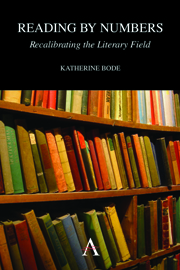Book contents
- Frontmatter
- Contents
- Acknowledgements
- List of Tables and Figures
- Introduction A New History of the Australian Novel
- Chapter 1 Literary Studies in the Digital Age
- Chapter 2 Beyond the Book: Publishing in the Nineteenth Century
- Chapter 3 Nostalgia and the Novel: Looking Back, Looking Forward
- Chapter 4 Recovering Gender: Rethinking the Nineteenth Century
- Chapter 5 The ‘Rise’ of the Woman Novelist: Popular and Literary Trends
- Conclusion Literary Studies in the Digital Future
- Notes
- Bibliography
- Index
Chapter 2 - Beyond the Book: Publishing in the Nineteenth Century
- Frontmatter
- Contents
- Acknowledgements
- List of Tables and Figures
- Introduction A New History of the Australian Novel
- Chapter 1 Literary Studies in the Digital Age
- Chapter 2 Beyond the Book: Publishing in the Nineteenth Century
- Chapter 3 Nostalgia and the Novel: Looking Back, Looking Forward
- Chapter 4 Recovering Gender: Rethinking the Nineteenth Century
- Chapter 5 The ‘Rise’ of the Woman Novelist: Popular and Literary Trends
- Conclusion Literary Studies in the Digital Future
- Notes
- Bibliography
- Index
Summary
The history of the book in Australia may be characterised as the movement of durable cultural goods over very large distances. Raw material was dispatched to Britain in the form of stories and other texts to be converted into books at the industrial heart of Empire. These were then shipped back to the Antipodes along with numerous other books to satisfy the prodigious appetites of Australian readers. Local publishing was a sideline undertaken by enterprising printers and booksellers.
Over the last decade, Australian literary studies has undergone a ‘transnational turn’, with a number of the field's leading scholars urging a shift ‘beyond the national paradigm’ to ‘explore and elaborate the many ways in which the national literature has always been connected to the world’. Book histories have been at the forefront of this process, with particularly profound consequences for conceptions of nineteenth-century literary culture. Where earlier literary histories sought in this century – especially the 1890s – the origins of a recognisably national literary tradition and canon, histories of the book (and of publishing and reading) in Australia emphasise the fundamental importance of British publishers and books for colonial authors and readers. This recent scholarship highlights Australia's position as a major export market for British books, ‘the largest…from at least 1889’, and according to Alexis Weedon, since 1878. British publishers are described as not only the main source of books for colonial readers but, as Craig Munro and John Curtain state in the epigraph to this chapter, essentially the only avenue of publication for Australian authors.
- Type
- Chapter
- Information
- Reading by NumbersRecalibrating the Literary Field, pp. 27 - 56Publisher: Anthem PressPrint publication year: 2012



